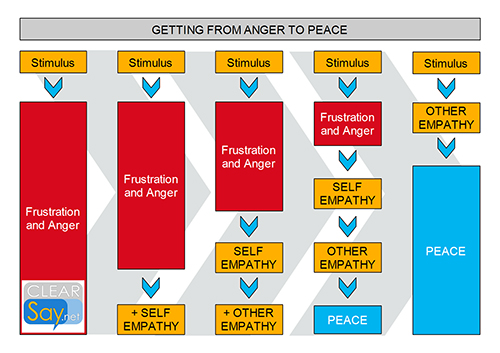 A concrete tool based on NVC and Practical Empathy A concrete tool based on NVC and Practical Empathy
by Scott Swain
Here I will show how to apply empathy to anger management: we first learn to self-empathize with our own situation and anger in a specific way and then move to empathizing for the person who stimulated our anger. I see the stages like this: Stage 0: Frustration / Anger. Stage 1: Add self empathy. Stage 2: Add empathy for other. Stage 3: Practice so you develop: Stage 4: AUTOMATIC/SUBCONSCIOUS empathy for other. Eventually, Stages 0 thru 3 barely happen, if at all. HOW DOES THAT WORK? With repetition, the brain begins to see a pattern of "The person did a thing and the typical outcome is for us to find that they were acting in accordance with their needs/values." So with each repetition of this pattern of "initial defensiveness --> empathy --> ah no defense needed" we are training our brains to eventually realize the "initial defensiveness" is not necessary in most situations. EXAMPLE
Let's say you are in often in traffic. Someone is driving in a way that stimulates your anger or frustration. You self-empathize by identifying your feelings and needs. The first ten times, that is all you do.
"I'm pissed off because my needs for security, respect, efficiency, and consideration were not met."
The first time you try this, you didn't notice any difference in your feelings. It took a few times. Then, around the fifth time, you noticed a difference. You feel lighter. The self-empathy was satisfying enough or enough of a release/relief that you felt open to trying empathy for the driver(s) that stimulated you.
So then, for the next five times you are stimulated by other drivers, you first do self-empathy and then empathy for the other driver(s).
"[First the self empathy] I'm pissed off because my needs for security, respect, efficiency, and consideration were not met. [Now the empathy-for-other] Hmmm why was that driver going so slow in front of me? Perhaps he was meeting his need for efficiency or security? Maybe if he is late one more time for work he will be fired? Maybe he just got a call from the hospital that a loved one is ill?"
During these last five times, after putting yourself in the other driver's shoes, you start to notice something. Your initial anger or frustration is just a bit less each time. The self-empathy comes easier and faster, too. And the empathy-for-other that you are having for the other drivers is ending up at positive feelings because of acceptance and understanding of their actions. The more this happens, the more your brain associates those positive feelings with the initial stimuli, and the less your brain will associate the initial stimuli with the negative feelings you used to have. So, with less of those initial negative feelings comes less need to self-empathize. And this leads to a shift where our initial reaction becomes: to automatically empathize with the person stimulating us. Did you like this article? Please upvote it on Steemit:
#empathy #independence #compassion #voluntaryism #liberation #liberal #respect #ideals #principles #empowerment #nvc #nonviolentcommunication #nonaggressionprinciple #nap #coercion #compassion #empathy
|